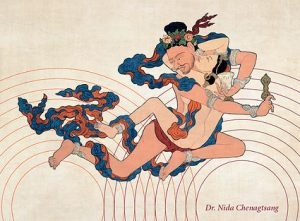
The Buddha once explained to a clansman called Pukkhusati how the idea of a “person” could be broken down into properties:
A person has six properties. Thus it was said. In reference to what was it said? These are the six properties: the earth property, the liquid property, the fire property, the wind property, the space property, the consciousness property. A person has six properties. (MN 140)
This will take some explication.
Speculative thought on the elements of earth, air, fire, and water were present in the Vedic tradition from the earliest recorded times, particularly in the Buddhist traditions of India, Tibet, and Southeast Asia, long before they ever reached ancient Greece and took their place in the school of pre-Socratic philosophy in the Western philosophical tradition.
We often hear the terms earth, air, fire, and water in connection with infinite space—infinite space becoming symbolical of a higher level of light and energy for which there is no speakable name.
A philosophy that is based on earth, air, fire, and water as the four basic elements (or properties) may sound a little simple, but there is more to it than just that. The formula is an allegorical representation standing for the changing cycles of all elements in the universe dependent on cause and effect.
Earth symbolizes the characteristic of extension, solidity, or rigidity in the process of change in the nature of matter and nothing is ever in a rigid or fixed or a permanent state. Everything in the universe is in a process of changing form and being recycled. Without the earth element of solidity, nothing could occupy space. There would be no solidity, only energy in space. This was one of the ancient mysteries couched in allegorical language.
Water, in turn, means cohesion and the quality of liquidity, fluidity, malleability, adaptability, or pliability. It coheres, flows around solid objects and clings to them, mirroring their form. It is this element that makes different particles of matter cohere, preventing them from being scattered. Both fluidity and contraction are properties of this element.
Fire, in turn, means heat or the lack thereof, causing expansion or contraction within interactive states of solidity and fluidity.
Air allegorically means vibration. All motion, vibration, oscillation, and pressure are caused by this element, sometimes called the mobile element.
We must note that earth, liquids (water), heat (fire), and gas (air) are always present in various proportions in any elemental state, in which one will always predominate in relative relationship to the others, and the relationships are always changing relative to temperature and other relative factors and conditions.
By relative proportions we mean, for example, that a sandy beach is solid to walk on because of the predominance of the earth element, but add enough water and it becomes quicksand in which the watery element predominates. This stands true to relative proportions for any combinations of solid, fiery, liquid, and gaseous states of matter. Water deprived of heat turns into ice. Similarly, water under great pressure (say in a fire hose) also behaves like a solid, as does compressed air in a hurricane.
In each case, the four elements are present in different proportions. This is the stuff of the study of modern science and not just some arcane nonsense. Even the table of chemical elements when broken down into its most basic indivisible essence leaves us with the four basic elements. (Hence the medieval interest in alchemy.)
It is interesting to note that in Buddhist meditation there are 40 concentration objects, 10 of which are earth, air, fire, water; the four colors blue, yellow, red, and white; plus space and light.
Ultimately, through penetrating concentration, even what we originally thought were the four basic elements can be further broken down and taken apart and analyzed as ultimately refractable movements and particles and energy vibrations in colors and space.
In the end, there is no ultimate solidity or permanence to anything.
In summary, there are two stages to our allegorical representation of reality: the first level is one of solidity, liquidity, heat-energy, and gaseous matter, which seems to have independent existence in the universe, but when broken down more closely, even the basic elements can be seen to be without fixed reality, because they may be analyzed and seen as mere particles and units of energy that are ever-changing while moving through natural processes.
The elements are ever-dependent on determining changing conditions and factors. When the elements cease to be in motion in the process of relations and relative interactions, the body breaks down into its elemental units and everything deteriorates, falls apart, and goes back into the natural cycle of the elements, thus causing the original fiery units of energy vibrating within the elements to return to their natural frequency levels to carry on the continuum of the universe in a realm ultimately lacking matter and solidity, which is akin to infinite space and light.
This connects the cohesion of elements and their subsequent separation into vibrations of energy to the ancient mysteries regarding insight into the ultimate nature of dissolution and death and the realm of space, light, and ultimate truth that lies beyond.

Now, when an aspirant in search of ultimate truth discerns that he is nothing more than a process of energy vibrations—arising and ceasing, arising and ceasing—then his idea of a bodily self as a fixed and solid entity is called into question. He realizes that his idea of the external world as a concrete unity has no reality, and he can either panic or relax. On the one hand, he might have cause for fear of losing everything that he thought was his; on the other hand, he might feel that there is nothing to hang on to and nothing to lose.
In the Buddha’s time, there were contemplative ascetics who sought freedom from human bondage in the world, and they would have welcomed this new way of looking at things. They were, indeed, ready to make a paradigm shift and change their view of the world.
“That seems to make sense,” we might say. “But where do feelings go? How do we explain that?”
About the consciousness element, the Dhatu-Vibhanga Sutta says:
“There remains only consciousness: … What does one cognize with that consciousness? One cognizes ‘pleasure.’ One cognizes ‘pain.’ One cognizes ‘neither pleasure nor pain.”
In dependence on a sensory contact that is to be felt as pleasure, there arises a feeling of pleasure . . .
In dependence on a sensory contact that is to be felt as pain there arises a feeling of pain . . .
In dependence on a sensory contact that is to be felt as neither pleasure nor pain, there arises a feeling of neither pleasure nor pain . . .
One discerns that “with the cessation of . . . sensory contact the concomitant feeling . . . that has arisen in dependence on the sensory contact . . . ceases, is stilled.” (MN 140)
When feelings are stilled, it is like a fire going out. All dependence on factors and conditions ceases.
Related features from Buddhistdoor Global
Concerning Dukkha
The Growth of Theravada Buddhism in Hong Kong
Happiness, Expectations, and Learning to be Losers: An Interview with Ajahn Brahm














